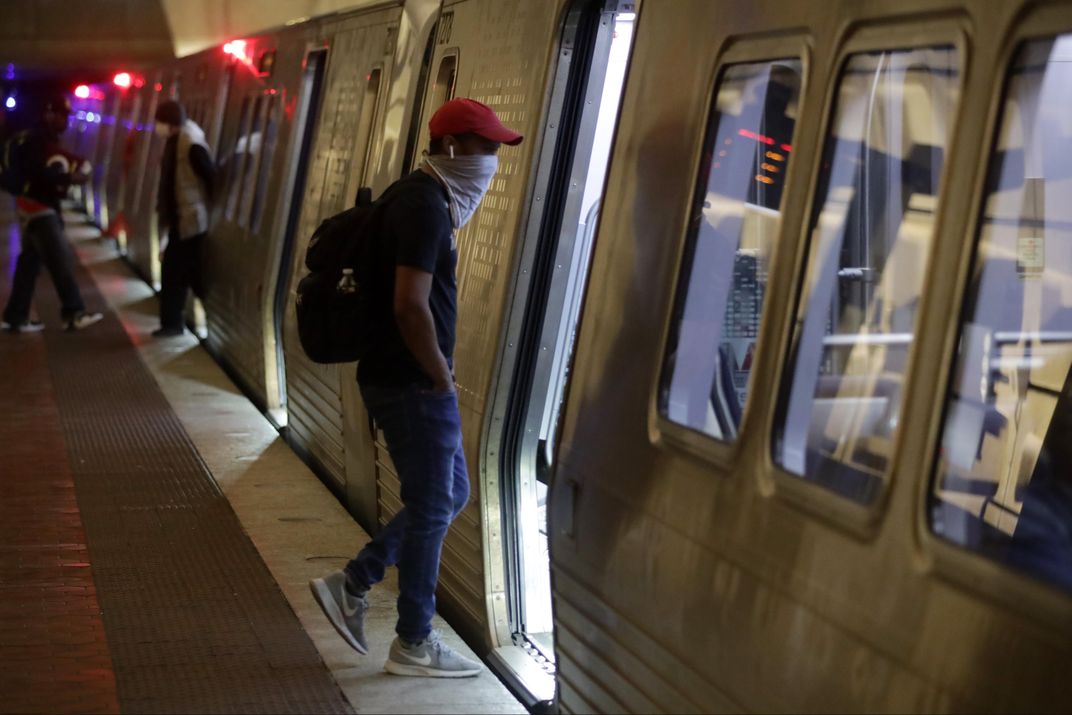Will Mass Transit Recover From the Pandemic?
Financial losses from low ridership and unexpectedly low sales tax revenue threaten the future of public transportation
/https://tf-cmsv2-smithsonianmag-media.s3.amazonaws.com/filer/2a/ec/2aec2d8b-404a-4b88-9a0a-98d3fb6e9e01/gettyimages-1226547581_1.jpg)
Before the COVID-19 pandemic, rush hour trips on crowded public transportation were a daily necessity for about one-in-ten Americans, especially for people living in cities. But the rise of the novel coronavirus, which seems to spread more easily in indoor spaces, led to a stark drop off in transit ridership.
By late April, ridership had dropped by about 74 percent in New York, 79 percent in Washington, D.C., and more than 80 percent in Boston and the Sanfranciso Bay Area, Janette Sadik-Khan and Seth Solomonow write for the Atlantic. Loss of riders’ fares, as well as the shortfalls of sales tax revenue amid the pandemic, are putting financial strain on many cities’ public transportation systems.
“I’ve been in this industry for over 30 years, and I have never experienced anything like what we’ve been dealing with in this pandemic,” Dorval Carter, Jr, president of the Chicago Transit Authority, tells Alejandro de la Garza at Time magazine. “There was no playbook for what we encountered.”
Sarah Feinberg, interim president of New York City Transit, describes the situation to Time as “apocalyptic.”
The transportation data collection app Transit found that essential workers, women, people of color and people with lower incomes still rely on public transit systems during the pandemic, Erin Lawrence reports for the Detroit Free Press. These people are disproportionally affected by recent service cuts to public transportation.
“Unless the economy comes ripping right back, and there’s a vaccine, and social distancing is eliminated, we fall off the financial cliff in 2023,” Jeffrey Tumlin, who leads San Francisco’s transit system, tells Pranshu Verma of the New York Times. “That would result in such severe service cuts that it puts us on what is called the transit death spiral.”
The "death spiral" is what happens when lower ridership leads to service cuts, which further reduce ridership, funding, and lead to more service cuts. In that situation, the spiral continues until the system collapses.

Public transportation received $25 billion in federal funding from the CARES Act, the economic stimulus bill signed in March, but an analysis by TransitCenter found that smaller systems can last longer on the funding they received than larger systems can, according to Time magazine. The larger systems, like New York City’s MTA, only received enough funding to help for under six months because it normally relies more heavily fares and sales tax.
Now, public transportation agencies hope that the next economic stimulus package will include more funding for them.
For transit agencies, the question becomes, how do they gain back ridership safely?
“Everybody’s not going to have a car. Everybody can’t afford a car. Everybody can’t maintain a car,” Glenn Tolbert, president of Amalgamated Transit Union Local 26, which represents Detroit Department of Transportation drivers, tells the Detroit Free Press. “Public transportation’s a great way to get around if you make people feel safe and it’s clean and you can depend on it.”
In the Atlantic, Sadik-Khan, the former commissioner of the New York City Department of Transportation, and Solomonow, co-author of Streetfight: Handbook for an Urban Revolution, point out that no COVID-19 clusters have been linked to public transportation, but have been linked to bars and churches, or places where people speak loudly or sing, which are activities that spray coronavirus aerosols and droplets more easily. The Centers for Disease Control and Prevention have released recommendations for riding public transit, including avoiding touching surfaces, practicing social distancing and wearing cloth face masks.
“Far from scaling back on public transit, cities across the country need a massive transit expansion that will enable them to avert the mobility meltdown that threatens to swallow them if even a fraction of former transit commuters take to cars,” Sadik-Khan and Solomonow write in the Atlantic. “The nation won’t recover if it adds a traffic crisis to the ongoing health and economic crises.”